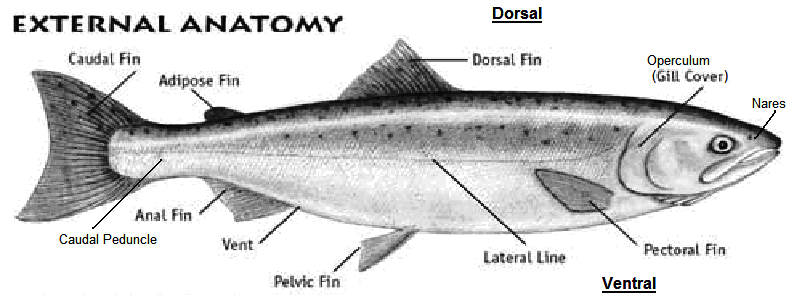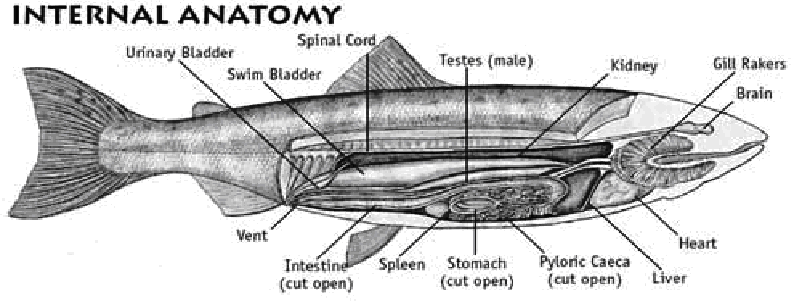
Dorsal: The top of the fish, or the back of a human.
Ventral: The bottom of the fish or the belly of a human.
The Fins
Dorsal Fin: Provides steering control and balance
Adipose Fin: There is no known use; however, this fin is often clipped to differentiate hatchery fish from wild fish
Pectoral Fins: Aids in stabilization, maneuvering, and braking.
Pelvic Fins: Aids in stabilization, maneuvering, and braking.
Anal Fin: Provides balance.
Caudal Fin: Also known as the tail fin it provides the main source of propulsion. Females use their caudal fin to dig their redd (nest).
Body Shape
The overall body of a salmon is streamlined for easier movement through the water.
External Body Parts
Nares: Fish use their nostrils for smelling, not for breathing.
Eyes: Fish eyes can see both to the left and right at the same time, and each eye can move independently.
Mouth: Allows the fish to take in food. All salmon have teeth, but some have bigger teeth than others.
Operculum (Gill Cover): Protects the gills, similar to how a human’s rib cage protects the lungs.
Lateral Line: A line that runs down the center of the fish. The line has little holes in it to help the fish sense vibrations in the water. These vibrations help fish tell the movements of other animals and objects in the water.
Scales: Protective outer layer. Scales overlap one another to form armor like plating around the fish. An up-close look at a scale reveals rings that can be used to determine the age of a fish, much like counting the rings on a tree.
Caudal Peduncle: The narrow region of the body of a fish just in front of the caudal fin. Provides the muscle to power the caudal fin.
Brain: This organ coordinates the messages received about the environment from the sensory organs i.e.: eyes, lateral line, nares etc. The forebrain controls smell, the midbrain vision, and learning responses to stimuli, and the hindbrain coordinates movement, muscles, and balance. (Nervous system)
Gills: Salmon breath oxygen. They extract oxygen from the water using gills. Salmon have 8 gills, 4 on each side of the head. Each gill consists of a bony arch fringed with thin-walled tissues called gill filaments. These filaments have many small blood vessels. Water is pumped in through the mouth and sent over the gills. As the water flows over the gills oxygen diffuses in to the blood and CO2 diffuses out of the blood. (Respiratory system)
Gill Rakers: Rakers are attached to the gill arch to guide food to the throat and to prevent it from entering the gills. (Respiratory system)
Kidney: Salmon have 2 kidneys that are joined together. Kidney’s help maintain the body’s fluid and chemical balance. The front kidney produces and replaces red blood cells and the back kidney filters waste from the blood. The Kidney is the main excretory organ that removes waste from the body. (Excretory system)
Testes/Eggs: Male and female gametes which create the next generation. (Reproductive system)
Spinal Cord: Runs parallel to the backbone and nerves branch from it to various parts of the body. (Nervous system)
Swim Bladder: The bladder is filled with gas and is used for buoyancy control. Gas passes into and out of the bladder from the blood. A full bladder will allow the fish to rise in the water column, while an empty bladder will allow the fish to move deeper into the water column. (Nervous system)
Urinary Bladder: Resourvoir which collects urine from the the kidneys. (Excretory System)
Vent: The body’s exit. The vent releases undigested materials as well as eggs and sperm during spawning. (Excretory system)
Intestine: Section of the digestive tract between the stomach and the anus where nutrients are absorbed and waste is transformed into fecal matter. (Digestive System)
Spleen: A store house of blood for emergencies as well as a recycling plant for worn-out red blood cells. It also produces white blood cells to help protect the body against disease and infection. (Circulatory system)
Stomach: Stores food and begins to digest food with digestion juices. (Digestive system)
Pyloric Caeca: A special intestinal pouch where most of the fish’s digestion and food absorption. (Digestive system)
Liver: Largest organ in the salmon’s body, it synthesizes and secretes the essential nutrients (amino acids i.e. proteins) that are contained in food. It also helps to maintain proper levels of blood chemicals and sugars. In addition it secretes green bile that is used to break down fats in food. (Digestive system)
Heart: 4 chambered hearts only receives low oxygenated blood (venous blood). The first chamber receives the venous blood. The blood then goes to the second chamber the atrium, which regulates the flow into the third chamber, the ventricle. The ventricle serves as the active pump which sends the blood to the forth chamber the arterioses which smoothes the pulses of the pump. The blood is then sent away from the heart to the gills where it releases carbon dioxide and becomes oxygenated. (Circulatory system)
Gallbladder: Stores the green bile secreted by the liver. (Digestive system)
References:
Behnke Robert J. 2002. Trout and Salmon of North America. Chanticleer Press, Inc.
Curtis Brian. 1949. The Life Story of Fish. Dover Publications.
Dore, Ian. 1990. Salmon, The Illustrated Handbook for Commercial Users. Van Nostrand Reinhold. 287
Goodman et al. 1991. Biology Today. Holt Brace Jovanovich, Inc. 552-568
Groot C. and Margolis L. editors. 1998. Pacific Salmon Life Histories. UBC Press University of British Columbia. 231-309
Wydoski Richard S. and Whitney Richard R. 2003. Inland Fishes of Washington. The University of Washington Press 25-28

